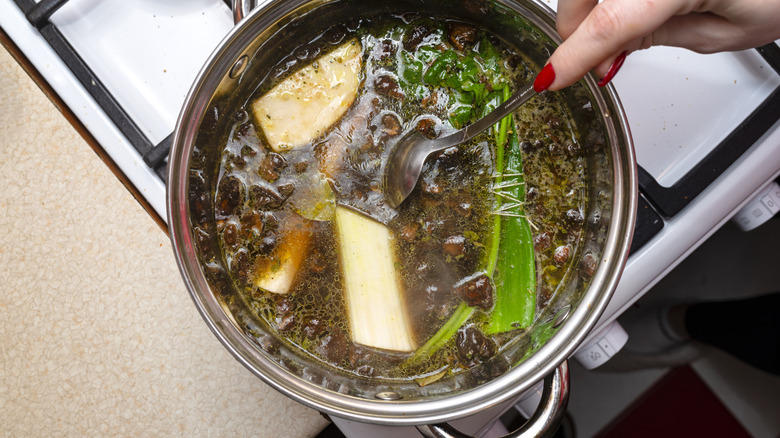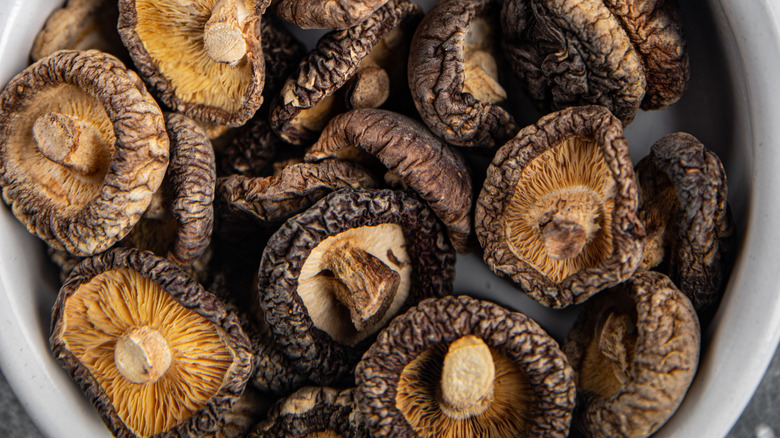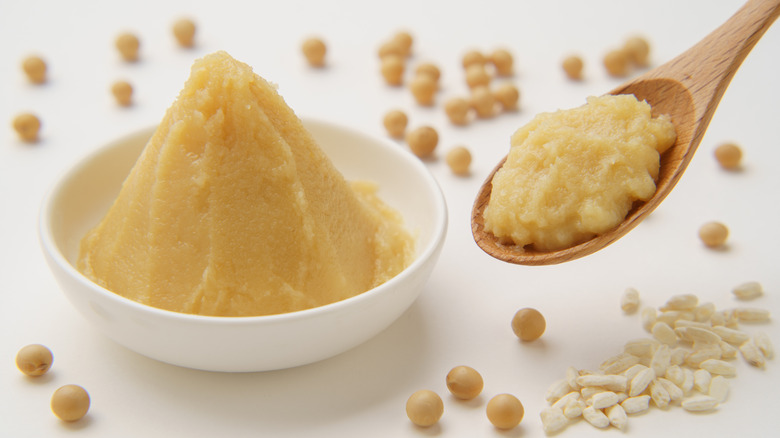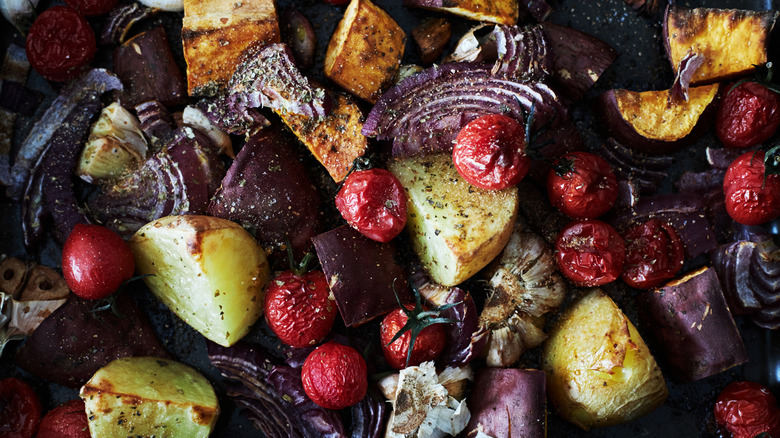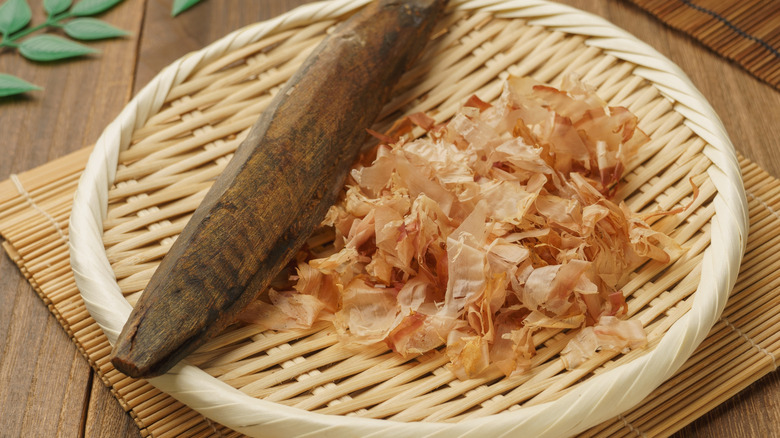5 Ways To Amplify The Flavor Of Your Vegetable Stock With Umami
We may receive a commission on purchases made from links.
Vegetable stock, whether store-bought or homemade, is one of those essential cooking ingredients that serves so many purposes. Whether you call it broth or stock (though there is a difference), it's perfect as the base for soups or in place of plain water for pasta or braised meats. But the core ingredients — potatoes, onions, celery, carrots — often produce rather mild results on their own. To add a little more oomph to your stock, amp up the umami flavor profile.
Umami-rich foods add a depth and complexity that traditional vegetable stock may be missing. Robust and earthy, umami is what makes both miso soup and hearty beef-and-mushroom stew sing. Luckily, adding layers of savoriness to an otherwise ordinary vegetable stock doesn't take much effort and there are many easy ways to incorporate more umami into your life (and your home cooking). Even better, many of them are plant-based. Here are five of the most spectacular savory ingredients for your vegetable stock.
Rethink your main ingredients
The most straightforward way to upgrade a vegetable stock is to change up the core components. One approach is to replace milder standards, like potatoes and onions, with vegetables boasting more flavor, like sweet potatoes, leeks, or daikon radish. Another is to drop additional veggies in the pot beyond your standard ingredients. Glutamate, an amino acid, is the primary driver for umami flavors and is common in lots of meats and vegetables to varying amounts. It's found in kelp and seaweed (crumbling sheets of nori into powder is one way to get an immediate hit of umami), but also in foods like spinach and tomatoes.
Bamboo shoots, lotus root, and edamame are other flavorful additions for an umami-boosted stock. You can even bake and add onion peels, rather than discarding them. However, be aware that some high-glutamate veggies, like kale and cauliflower, can impart bitterness if cooked too long. Consider adding them towards the end or avoiding them altogether.
If you're adding seasoning, use MSG (monosodium glutamate) in place of some of the salt for an umami-loaded seasoning. Don't worry: it's a myth that MSG causes adverse reactions for the vast majority of people. In fact, MSG exists because a scientist in 1908 was pinpointing what he found so tasty in kelp, and he coined the term umami ("delicious taste") to describe it.
Reconstitute dried mushrooms for the liquid
Dried mushrooms are more umami-rich than fresh versions, because the drying process converts complex proteins into glutamate. You can use them to create as much or as little umami-rich liquid as you want, and use it to enhance traditional stock. Grab a packet of Marky's Dried Whole Shiitake Mushrooms and toss them into lukewarm water for 20 or 30 minutes. You'll have two delicious products: reconstituted mushrooms (that you can add to the stock or use in other dishes), and an earthy, deeply savory mushroom tea. In fact, this is one way to make dashi, a savory stock used in many Japanese dishes. Dashi gets added to eggs to make tamagoyaki, and it's integral to a good teriyaki sauce.
Making an entire stockpot of dashi can get expensive. However, it's a great way to create a bowl of liquid flavoring, adding a little or a lot to your main stock to taste. The technique works with any dried mushrooms, but shiitake produces some of the most umami-driven flavors.
Take your cues from miso soup
Authentic dashi involves fresh or preserved ingredients, time, and even fermentation. But many Japanese families rely on instant dashi powder to give dishes an umami-packed upgrade. Called dashi no moto, dashi powder consists of little granules of intense flavor, like mini bullion cubes. One of the more common brands, Ajinomoto Hondashi bonito soup stock, imparts a subtly oceanic umami, along with hints of smoke and sweetness. Even a little tossed into your stockpot will add more structure and complexity.
While dashi is important for making miso soup, the other component is miso paste, a dense, vegemite-like substance made from fermented soybeans, salt and koji mold. It's incredibly rich, and a little goes a long way. The general recommendation is about a tablespoon per serving, but that doesn't necessarily scale up. Add a tablespoon at a time until you get the flavor profile you want. Miso paste is packed with salt, so you won't need to add as much as you normally might when seasoning stock or broth.
Make a roasted vegetable stock
Vegetable stock is commonly made using raw veggies, often whatever's on hand. Many people who nosh on lots of vegetables during the week save scraps in the refrigerator or freezer until they have enough for stock. But there's no reason you can't roast up a bunch of carrots, celery, onions, garlic, and daikon specifically to toss into a pot of hot water. The beauty of this method is that the caramelization that happens in the oven brings deep flavor and color to the stock.
Lay out the veggies — either scraps or diced chunks — and drizzle oil as with any roasted vegetable dish. Add fresh ground pepper and your preferred spices, though you may want to hold off on the salt if you're salting the stock itself. You'll also want to be aware of the mistakes keeping you from perfect roasted vegetables, even if you're planning on simmering the heck out of them. Avoid leafy greens that could singe and add bitterness. This also isn't the time for broccoli or cauliflower, which can dominate a stock following roasting. You may need to skim off oil as the stock simmers, depending on how much was used during roasting.
Bonito flakes give fishy depth to stock or broth
Technically, when you add bonito flakes, your concoction is no longer solely a vegetable stock. That's because bonito flakes (also called katsuobushi) consist of dried fish (skipjack tuna, to be precise) and are yet another ingredient used in making Japanese dashi. The brittle, flavor-packed bits of goodness are also a popular seasoning on top of rice.
Buy bonito flakes in small or large bags, like the one-pound version from Yamahide Hana bonito flakes, but a little goes a long way. You'll use between ½ and 1 tablespoon of flakes per cup of water. Make an even fancier dashi base by combining bonito flakes and a chunk of kombu seaweed. This can either become the primary stock base, or if you just want a hint of umami, add in a bit at a time to regular, salted water. Just remember that your vegetable stock may no longer be suitable for vegetarians or vegans.

